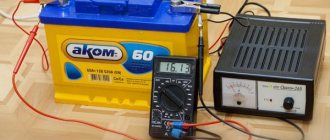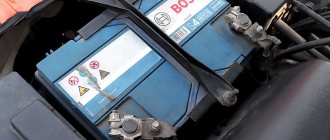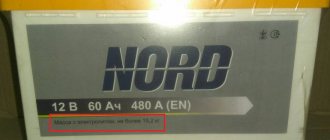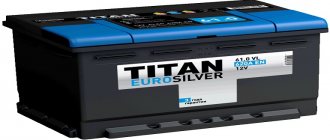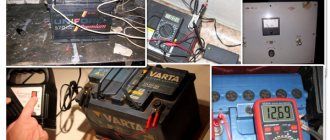_YAK6296sm
A car battery is a seasonal product, although it is used all year round. When the birds are singing outside and warm oil is splashing inside the engine, it is not difficult to crank the crankshaft - even a half-dead battery can do it. But in the cold it is not easy for the starter, and it strives to turn into a purely active resistance, consuming a very large current. As a result, the battery tends to fail, and the owner will have to go to the store.
Russian standard
Russian battery standard
1
- Be careful with acid.
2
- Explosive.
3
- Keep away from children.
4
- Flammable.
5
- Protect your eyes.
6
- Read the instructions.
7
- Recycling sign.
Recyclable. 8
— Certification body.
9
— Designation of recycling features.
Do not throw into waste. 10
— The EAC mark confirms product compliance with the standards of the countries of the Customs Union.
11
— The material that is used in the cells in the production of the battery.
Important for subsequent battery disposal. There may also be other additional icons that indicate the technology used. 12
- 6 elements in the battery.
13
- The battery is a starter battery (for starting the car engine).
14
- Nominal battery capacity.
In this case it is 64 Amp-hours. 15
— Location of the positive terminal on the battery.
Polarity. In this case, “left”. 16
— Nominal capacity Ah.
17
- Discharge current at -18°C according to the European standard, also known as “cold start current”.
18
— Battery weight.
19
— Technical production conditions, compliance with standards.
20
— State standard and certification.
21
— Address of the manufacturer.
22
- Barcode.
Designation on a domestic battery
Let's start the review with the most popular and widespread Russian standard in our country. It has the designation GOST 0959 - 2002. In accordance with it, the marking of car batteries is divided into four parts, which can be conditionally divided into four numbers. In particular:
- The number of “cans” in the battery . Most batteries for passenger cars have the number 6 in this place, since that is how many 2-Volt cans a standard battery has (6 pieces of 2-V each give a total of 12-V).
- Battery type designation . The most common designation would be "ST", which means "starter".
- Battery capacity . It corresponds to the number in third position. This can be a value from 55 to 80 Ampere hours (hereinafter referred to as Ah) depending on the engine power of the car (55 Ah corresponds to an engine with a volume of about 1 liter, and 80 Ah for a 3 liter or even larger ).
- Battery design and type of material of its case . In the last place, as a rule, there is one or more letters, which are deciphered as follows.
| Designation | Decoding letters |
| A | The battery has a common cover for the entire case |
| Z | The battery case is flooded and it is fully charged initially |
| E | The monoblock battery case is made of ebonite |
| T | ABK monoblock case is made of thermoplastic |
| M | The body uses separators like mineral plastic made of PVC |
| P | The design uses polyethylene envelope separators |
As for the mentioned starting current , in the Russian standard it is not indicated explicitly on the given nameplate. However, information about it must be on the stickers next to the mentioned plate. For example, the inscription “270 A” or a similar value.
Table of correspondence between the type of battery, its discharge current, minimum discharge duration, overall dimensions.
| Battery type | Starter discharge mode | Overall dimensions of the battery, mm | |||
| Discharge current strength, A | Minimum discharge duration, min | Length | Width | Height | |
| 6ST-55 | 255 | 2,5 | 262 | 174 | 226 |
| 6ST-55A | 255 | 2,5 | 242 | 175 | 210 |
| 6ST-60 | 180 | 3 | 283 | 182 | 237 |
| 6ST-66A | 300 | 2,5 | 278 | 175 | 210 |
| 6ST-75 | 225 | 3 | 358 | 177 | 240 |
| 6ST-77A | 350 | 2,5 | 340 | 175 | 210 |
| 6ST-90 | 270 | 3 | 421 | 186 | 240 |
| 6ST-110A | 470 | 2,5 | 332 | 215 | 230 |
04sm
The inscription 60 Ah is more of a tribute to tradition than useful information.
Unfortunately, almost none of the manufacturers indicate the battery reserve capacity, measured in minutes. The inscription 60 Ah is more of a tribute to tradition than useful information. Unfortunately, almost none of the manufacturers indicate the battery reserve capacity, measured in minutes.
Indeed, if the capacity is 60 A•h, then arithmetic dictates: a current of 600 A should be delivered for approximately 0.1 hour or 6 minutes! But the real count is only tens of seconds... The thing is that the battery capacity depends on the current! And at the specified current, the battery capacity is no longer 60 A•h, but much less: approximately 20–25! The inscription 60 A•h only means that for 20 hours at a temperature of 25ºC you can discharge your battery with a current equal to 60/20 = 3A - and nothing more. At the same time, at the end of the discharge, the voltage at the battery terminals should not drop below 10.5 V.
Differences between standards
Before moving directly to the question of what the markings on the battery mean, you need to know the following. On Russian batteries, the “plus” is located on the left terminal, and the “minus” on the right (if you look at the battery from the front, from the sticker side). On batteries manufactured in Europe and Asia (in most cases, but not always) the opposite is true. As for American standards, both options are found there, but more often the European one.
Car battery polarity and standard
In addition to the marking of car batteries, they also differ in terminal diameters. Thus, the “plus” in European products has a diameter of 19.5 mm, and the “minus” - 17.9 mm. Asian batteries have “plus” with a diameter of 12.5 mm, and “minus” - 11.1 mm. The difference in the diameter of the terminals was made to eliminate errors associated with connecting the batteries to the vehicle's on-board electrical network.
In addition to capacity, when choosing a battery, it is necessary to take into account the maximum starting current for which it is designed. The marking of a car battery does not always contain a direct indication of such information, and may be designated differently in different standards; each standard has its own nuances.
The so-called cold cranking current is the starting current at a temperature of -18°C.
Car battery 2014
The main area of application of AGM is cars with Start-Stop modes.
This battery even says: Start Stop! The main area of application of AGM is cars with Start-Stop modes. This battery even says: Start Stop!
Formally speaking, an AGM car battery is the same lead-acid product that many generations of motorists are accustomed to, but at the same time it is much more advanced than its ancestors and in the near future will completely displace them from the market.
AGM (Absorbent Glass Mat) is a technology for manufacturing batteries with absorbed electrolyte, which is impregnated with the micropores of the separator. Developers use the free volume of these micropores for closed recombination of gases, thereby preventing water from evaporating. Hydrogen and oxygen leaving the negative and positive plates, respectively, enter the bound environment and recombine, remaining inside the battery. The internal resistance of such a battery is lower than that of its “liquid” predecessors, since the conductivity of the fiberglass separator is better compared to traditional polyethylene “envelopes”. Therefore, it is capable of delivering higher currents. A tightly compressed package of plates prevents the active mass from crumbling, which allows it to withstand deep cyclic discharges. Such a car battery can work even upside down. And if you break it into pieces, then even in this case there will be no toxic puddle: the bound electrolyte must remain in the separators.
Today's areas of application of AGM are cars with a “Start-Stop” mode, cars with increased energy consumption (EMERCOM, ambulance), etc. But tomorrow, a “simple” car battery will slowly become history...
Are AGM and regular batteries interchangeable?
An AGM car battery replaces a “regular” one 100%. Is such a replacement necessary if the car only needs a serviceable standard battery? That’s another question. But the reverse replacement, of course, is incomplete - it can be used in practice only in a hopeless situation and as a temporary option.
Is it true that a 50 Ah AGM car battery can be used instead of a regular 90 Ah battery?
Sorry, this is nonsense. How can you almost halve the charge and say that there will be no difference? Lost amp hours cannot be compensated by any technology, not even AGM.
Is it true that a high current from an AGM battery can destroy a car's starter?
Of course not. The current is determined by the resistance of the load, and in this case, the starter. And even if a car battery can produce a current of a million amperes, the starter will take exactly as much as from a regular battery. He cannot break Ohm's law.
On which cars is it undesirable to use AGM?
There is no such restriction. Even if we consider ancient cars with a completely faulty relay-regulator and unstable voltage in the network, then in this case the AGM car battery will die no sooner than usual, but even later. The voltage limit above which trouble can occur is approximately 14.5 V for conventional batteries and 14.8 V for AGM.
Which car battery is more susceptible to deep discharge - AGM or regular?
Regular. After 5-6 deep discharges they can become completely “offended”, while for AGM this number is practically unlimited.
Can an AGM car battery be considered completely maintenance-free?
This is a matter of established terminology, which works more in favor of PR than science. Strictly speaking, this term is incorrect - both for AGM batteries and for any other car batteries. Only a AA battery can be called completely maintenance-free, but any lead-acid car battery, generally speaking, is not. Even the technology leader - the AGM battery - is sealed, let's say, 99%, but not 100%. And such a battery still needs to be maintained - check the charge, recharge if necessary, etc.
How are gel batteries different from AGM?
What is a battery and why is it needed in a car?
A car battery, like a generator, serves as a source of electricity and performs the following functions:
- supplies current to the starter when the engine starts;
- supplies power to the switched-on consumer when the generator is operating;
- participates in transient processes that require high voltage;
- helps smooth out the pulsating current.
Lead-acid batteries in passenger cars differ in type. Over time, devices are improved. One battery includes 6 separate batteries connected in series. The body of such elements is made of polypropylene, it is resistant to acids.
One of these mini-batteries includes several positive and negative electrodes. The purpose of the separator is to insulate electrodes of opposite polarity. Each individual electron is made of lead or a lead-calcium alloy.
This type of battery has a low charge level. Hybrid batteries have a simpler design. To ensure that the electrodes have increased resistance to corrosion, a small amount of tin is added to the lead. The structure of the electrodes resembles a lattice. Each is in an electrolyte - a sulfuric acid solution (or gel).
IMG_3883
By the way, the most popular Optima battery is also AGM!
It is only called gel on forums, but this is fundamentally incorrect. By the way, the most popular Optima battery is also AGM! It is only called gel on forums, but this is fundamentally incorrect.
At least because gel car batteries... do not exist! The question is generated by the well-established incorrect terminology: gel batteries are used, for example, in electric forklifts or scrubber dryers. The electrolyte in them, unlike conventional car batteries with liquid acid, is in a thickened state. In batteries with AGM technology, the electrolyte is bound (impregnated) in a special fiberglass separator.
Note that the most popular Optima battery is also AGM, and not gel at all.
What is battery reserve capacity?
This parameter shows how long a car with a damaged alternator will last on a cold rainy night. An expert will say differently: how many minutes will it take for the voltage at the terminals of a battery delivering a current of 25 A to the load to drop to 10.5 V. Measurements are carried out at a temperature of 25 °C. The higher the result, the better.
What to look for when choosing a battery
When purchasing such a device, you should consider its size so that it fits perfectly in the seat. Maintenance-free or serviceable design must also be taken into account. Although this is more a matter of taste and technical features of the device itself. There are fewer worries with unattended ones, but the chance of resuscitating them is not great.
Vehicles equipped with a start-stop system must be equipped with suitable batteries, marked accordingly. Otherwise, there is a risk of getting stuck at a traffic light and not being able to go anywhere today under your own power.
When working in severe frosts, the requirements for battery quality are especially high. The best for northern latitudes will be Japanese products or products of the Tyumen Battery Plant. However, before purchasing, you should always read reviews about a specific model on the Internet. Better yet, check out our battery rating.
nigga batteries
In warm countries, a car battery does not experience winter problems with thickened oil and a sluggishly rotating starter...
In warm countries, a car battery does not experience winter problems with thickened oil and a sluggishly rotating starter...
We hope that our tips will help you choose the right battery and refresh your memory of interesting “battery” information.
Good luck on the roads!
Car battery: chosen by the “Behind the Wheel” expert
Battery sizes and data tables
What is the charge rate of a car battery and how to check it
In this section we present the basic digital data characteristic of each standard in the production of rechargeable batteries for cars. The dimensions of car batteries will also be presented, table 1, 2, 3, 4.
European assembled batteries
In Europe, batteries are produced that have the following capacitance characteristics - from 40 to 225 Ah (ampere hours). Battery sizes are divided into 2 groups:
- Batteries with capacities of 40 – 70 Ah have the following dimensions:
- Width – 174 mm.
- Height – 174 or 189 mm.
- Length – 174 – 241 mm.
- Batteries with capacities of 70 – 225 Ah have the following dimensions:
- Width – 174 – 239 mm.
- Height – 174 – 241 mm.
- Length – 277 – 517 mm.
Asian assembled batteries
In Asia, batteries are produced that have the following capacitance characteristics - from 35 to 120 Ah (ampere hours). They are divided into 2 groups:
- Batteries with capacities of 35 – 70 Ah have the following dimensions:
- Width – 126 – 174 mm.
- Height – 189 or 226 mm.
- Length – 186 – 260 mm.
- Batteries with a capacity of 90 – 120 Ah have the following dimensions:
- Width – 174 mm.
- Height – 224 mm.
- Length – 305 mm.
It is worth noting that the American standard is completely identical to the European one. The selection of a battery in this segment can be done by studying tables 1 and 2. Changes in the design of these batteries may depend on the terminals.
Starting current
mir-akb.com.ua
Another fundamental characteristic that plays an even greater role than capacity. Indicates the maximum amount of current that the battery is capable of delivering in a short period of time from 10 to 30 seconds at a temperature of –18 ° C. The starting current is always indicated on the label in amperes. The higher its value, the easier it is to start the engine.
There are three main standards for marking inrush current, depending on the battery manufacturer and country of destination. In Russia and Europe, the EN classification is common, in Germany - DIN, and in the USA - SAE.
EN, DIN, SAE standards vary. Therefore, when comparing the performance of two batteries, pay attention to the values.
The average starting current for cars with gasoline engines is about 255 A, for diesel engines - about 300 A.
If possible, it is better to buy a battery with a higher starting current. Such batteries are more expensive, but are guaranteed to start the engine even in severe frost.
